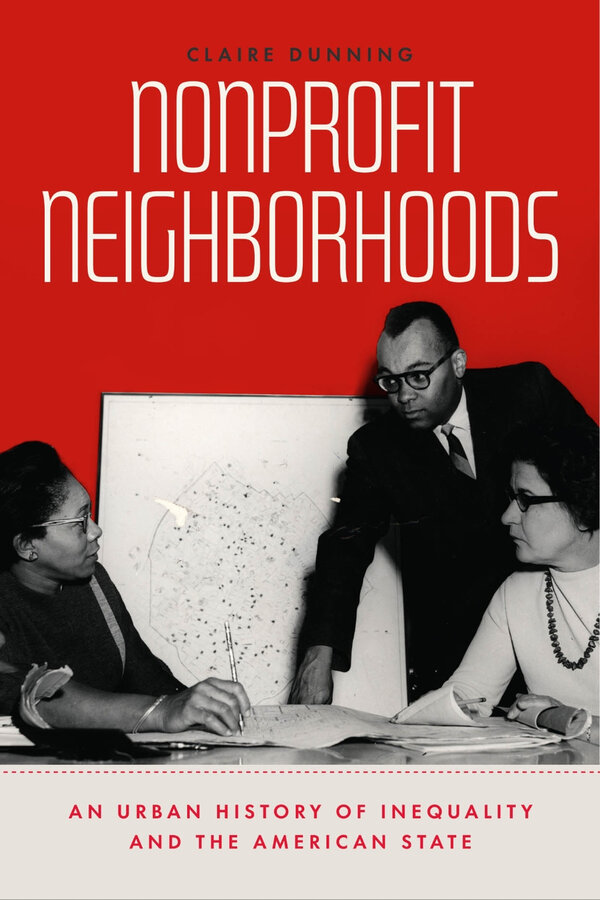Nonprofit Neighborhoods: An Urban History of Inequality and the American State
In 2014, when Massachusetts launched its “pay for success” social impact bond program—in which private investors would front the funding for nonprofit efforts to address a social issue—it was hailed as an innovative, data-driven public-private partnership that would deliver demonstrated results and cost savings. Yet, as Claire Dunning illustrates in Nonprofit Neighborhoods: An Urban History of Inequality and the American State, it was just the latest chapter in a long history of public-private initiatives that so far have not fulfilled their promise.
An assistant professor of public policy and history at the University of Maryland, College Park, Dunning defines “nonprofit neighborhoods” as “places where neighborhood-based nonprofit organizations controlled access to the levers of political, economic, and social power and mediated the local manifestations of the state and market.” While that definition might suggest the nonprofits have power, Nonprofit Neighborhoods illuminates how, through government and public-private grantmaking, nonprofits in Boston’s low-income and minority neighborhoods came to provide the services that government should have provided and, even more disturbingly, how that funding mechanism was used to appease, manage, and control grassroots movements for policy reform and inclusion.
By examining how federal funding for neighborhood nonprofits transformed urban governance starting in the late 1940s, Dunning seeks to shed light on “why, despite efforts to the contrary, it carried economic, political, and social inequities present at midcentury into the new millennium.” Each chapter focuses on a stakeholder group—the city, grantees, residents, bureaucrats, lenders, partners, and coalitions—while advancing the historical narrative decade by decade. She details the political, economic, and social contexts shaping events and policy developments; follows the evolution of an alphabet soup of city agencies and nonprofits; and profiles activists and nonprofit leaders, politicians, and businesspeople as they clash and compromise. This framework makes for vivid storytelling, thought it also results in some repetition as events are described from different points of view.
According to Dunning, the Johnson administration’s War on Poverty defined the role of neighborhood nonprofits by circumventing, at least initially, lower tiers of government and in using grantmaking as a policy tool not only to reduce poverty but also to enable traditionally excluded groups to participate in governance: “As neighborhood nonprofits mediated, for some, access to public goods and services, participation, and representation, they also facilitated a form of privatized inclusion, simultaneously making urban governance more decentralized, diverse, and participatory, and more insulated from the structural changes African American and Latinx residents had been calling for.” Yet, despite the mandate of “maximum feasible participation,” despite the Action for Boston Community Development (ABCD) board including poor and/or Black residents in response to a demand from Martin Luther King, Jr., she points out, “selective grantmaking could not undo legacies of withheld spending and racial exclusion. By nature of being selective and rooted in scarcity, grantmaking enforced continued precarity among neighborhood organizations and disciplined them to stay within what funders deemed appropriate, nonpolitical activities.”
This, essentially, is the recurring theme of Nonprofit Neighborhoods: “Rather than remedies for racial and economic inequality, these federal grantmaking programs enabled segregation, poverty, and exclusion to persist in new forms, as marginalized populations continued to disproportionately live in nonprofit neighborhoods and rely on neighborhood nonprofits for public resources, representation, and rights. This was the practice of democracy at its fullest and hollowest.”
None of the stakeholder groups escapes this indictment except, to some extent, the grantees, who had little choice: “Outsourcing responsibility for improving broken systems via grants, loans, or contracts to eager nonprofits” that gave the appearance of grassroots participation and inclusion was convenient for both government and private funders, Dunning writes, while cash-strapped nonprofits agreed to, and inadvertently justified, governing arrangements that they would have rejected politically and ideologically. At the same time, with public funding came expectations of transparency, and grant recipients without the financial management capacity faced accusations of mismanagement.
Philanthropy also comes in for criticism. In the 1960s the Ford Foundation’s Gray Areas initiative, which supported community-level and nonprofit-led efforts to address the inadequacies of urban renewal, supported ABCD, but in Dunning’s analysis, its program officers, ABCD board members, and presidential committee members all “had similar blind spots: the assumptions that local solutions could address structural problems, that increasing participation via private routes could substitute for a sharing of public power, and that improved programs or services could reduce poverty.”
Moreover, while neighborhood nonprofits’ response to the 1967 uprising and the 1974 busing crisis showcased their ability to mobilize quickly and how crucial they had become to the city, when they sought to address “some of the real issues of educational reform,” city grant managers encouraged them to seek private funding on their own.
By then, some neighborhood nonprofits had begun to expand their work to include policy advocacy to address structural issues; others had launched community development corporations (CDCs) to provide affordable housing, in part to develop revenue streams. Ford Foundation grants and low-interest loans to Greater Boston Community Development (GBCD) helped direct capital to CDCs by attracting new investors, structuring aid as loans, and framing social goals in economic terms. In 1979, the foundation launched the Local Initiatives Support Corporation (LISC) but again, according to Dunning, “put resources into nonprofit neighborhoods and helped make them profitable, without necessarily making them equitable.”
The Ford Foundation was not alone: As the rise of neoliberalism in the 1980s further accelerated the flow of private capital into neighborhood nonprofits and CDCs, the “[p]roponents of these new tools deliberately traded the unpredictability of philanthropic and government grants for the unpredictability of the market, steering CDCs toward commercial organizational forms and activities.” Instead of bringing about a structural change in an unequal housing market, the influx of private capital created “a privatized and financialized inclusion.” The inclusion of Black community activists on the Boston Housing Partnership board did not lead to an examination of the intersections of race, policy, and housing finance; the focus remained on the investors’ ROI.
The final phase of this dismal history saw the development of coalitions that were larger than one-off partnerships and anchored in urban space and of the federal Empowerment Zone/Enterprise Communities grantmaking program. Yet the poverty rate increased in the targeted zone between 2000 and 2009, and the census tracts with the richest nonprofit infrastructure were also the most distressed.
Here Dunning differentiates between systems change and structural change: Urban revitalization and poverty reduction “are rooted in politics and policy and not in practice.” Despite the fact that calls for better systems of social welfare and urban governance are not new, and despite the profound systems changes in how cities are governed and social services are distributed, Dunning argues, an improved, more inclusive delivery system has not and cannot substitute for the power to design, control, and shape the system itself, because “[t]he kind of political advocacy and protest often required to move a structural agenda was precisely the kind of activity discouraged, if not outright prohibited, under government grantmaking.”
Nonprofit neighborhoods were not designed to be vectors for economic restructuring or political empowerment, regardless of the protests of activists, residents, and nonprofit workers. But Dunning also insists that the lack of structural change diminish the past half-century of neighborhood nonprofits’ achievements or discourage their ongoing work. They have improved the lives of urban residents, directly and indirectly, including through organizing and advancing conversations about rights, justice, and equality.
The complicated, troubling history presented in Nonprofit Neighborhoods makes it ever clearer that building social movements and political power is the most productive path to structural change—slow work that is difficult to measure and, not coincidentally, to get funded.
As Dunning reminds us, calls for implementing structural change to address the root causes racial/ethnic disparities and poverty, instead of providing services to manage those issues, is not new. Nor are calls to listen to the people closest to the issue, to trust grantees, and to prioritize bottom-up instead of top-down solutions new; they simply had not been heeded. In that context, the lessons that Nonprofit Neighborhoods offers on missed opportunity after missed opportunity seem particularly valuable and relevant today.
Kyoko Uchida is features editor at Philanthropy News Digest.








